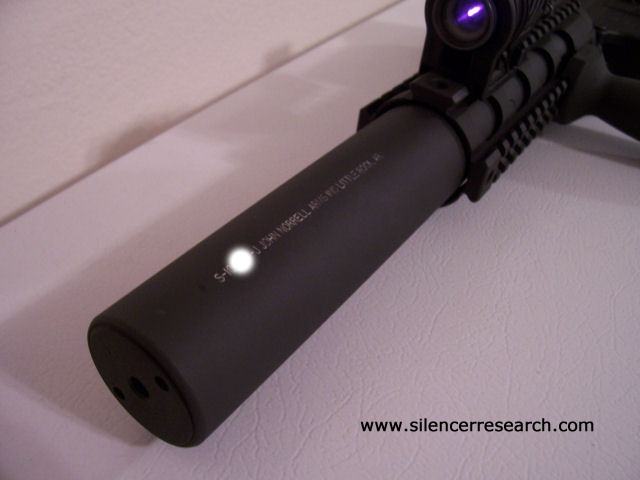

This suppressor was built for me by master craftsman and class 2 manufacturer John Norrell. This particular suppressor was built to take large volumes of full auto fire and was originally designed to be fired on an M16 Full Auto with Ciener 22 conversion kit and custom upper by Kuehl Precision Firearm. The ultimate in suppression were the major criteria. The suppressor, naturally, must be user serviceable since 22 ammunition is exceptionally dirty. The can performed beyond expectations. Bolt chatter is all that is heard (with the exception of the bullets striking the target, which can be rather loud depending on what you are shooting).

The can has a large expansion chamber in the rear of the suppressor to accept large volumes of powder gas. The round then passes thru 5 baffles and liners. The baffles and liners are place inside the suppressor in such a way as to not allow for any carbon/lead buildup to touch the registered outer tube. The can seats over the barrel and is tied into the back of the suppressor by an "O" ring that is seated into a specially machined groove on the barrel.
Cleaning the Norrell Can
Cleaning the Norrell can is easy with a few simple tools. Norrell supplies the spanner wrench with the can to remove the endcaps. You then use a piece of 1" schedule 40 PVC pipe to push the baffles out. Then you clean them off by hand as best as possible. Some of the mess inside the can is a thickened powder carbon that would remind you of wet gray chalk. Some of this will have hardened and it can be scrapped off by hand. This is what it looks like:
What you cannot scrape off by hand is the thick, black carbon/lead deposits that are inherent in all 22 suppressors, especially 22 suppressors used for full auto. Any 22 suppressor rated for full automatic fire MUST be cleaned by disassembling the can into its components and cleaned manually. Soaking suppressors to remove thick, black carbon/lead buildup cannot be satisfactorily accomplished. When a 22 round is fired from a suppressor, a tiny amount of molten lead is deposited inside the can. Given the relatively low melting point of lead and the amount of heat generated by gunfire, one can see easily how suppressors can become clogged with lead buildup. The carbon mess hardens as the molten lead vapors spray over it. The result looks like this:
Note the lower baffle in the picture. The bullet enters on this side of the baffle and exits the other side. Keep in mind that the job of a suppressor is to contain and cool hot gasses. This is what clogs up a 22 suppressor so quickly. The next image is the lower baffle in the previous picture partially cleaned. I clean the baffles with glass beads inside a small bead blaster:
You can see the shiny, freshly blasted lead deposits inside the baffle. The light is shining on the baffle at 11 to 12 o' clock in this picture. The following are additional pictures of the baffles:
This picture shows the exit side of the baffles and the liners are above them. The baffle on the far left was bead blasted for contrast.
A closer picture of the exit side of the baffles showing the carbon chalk like buildup. While in some cases being quite caked on, this buildup can be removed by hand and ostensibly by soaking.
The carbon/lead packed side of the baffles. The bullet enters this side.
I was in a hurry when I did this particular cleaning so I did not take time to remove every single particle of fouling. The suppressor was by no means getting louder, but I had fired over 5000 rounds thru the suppressor and decided it was time to do the first cleaning. Here are the baffles after some bead blasting: